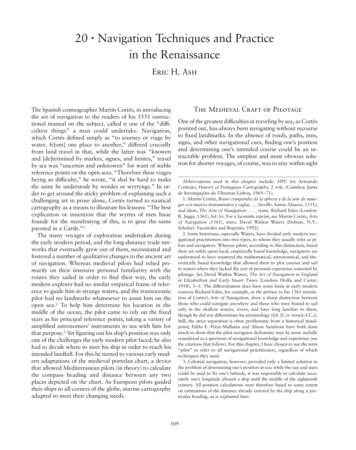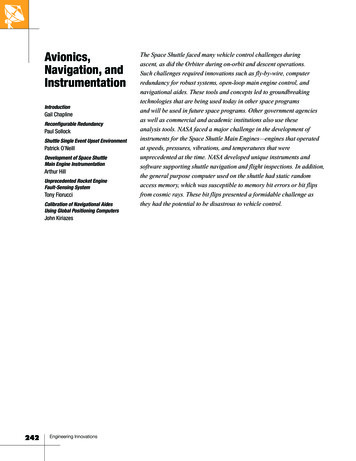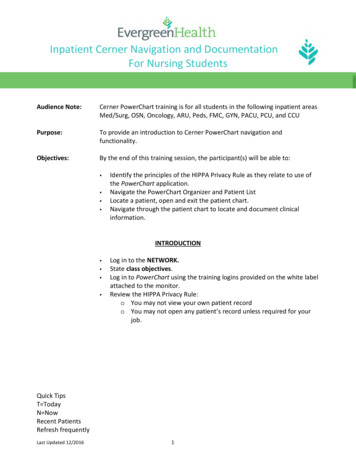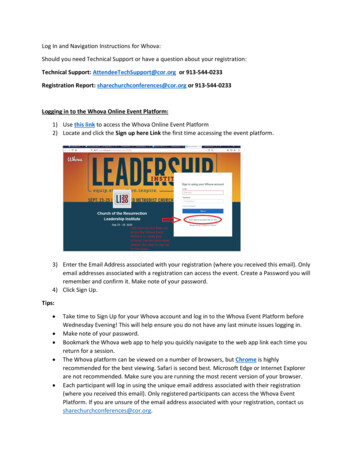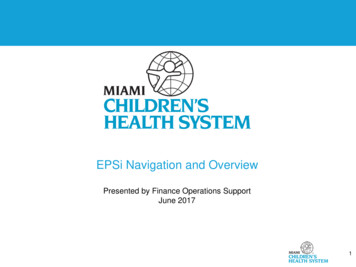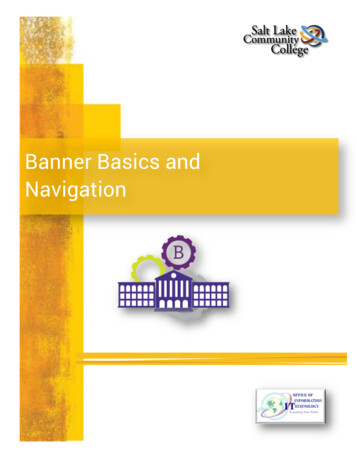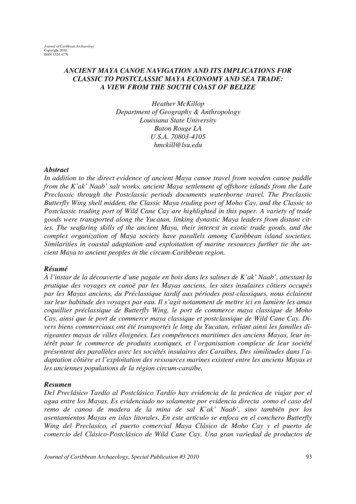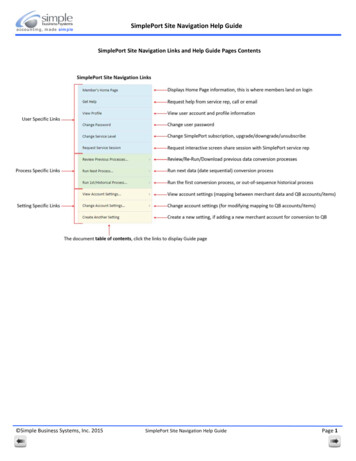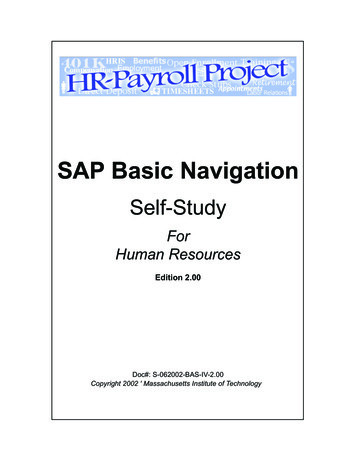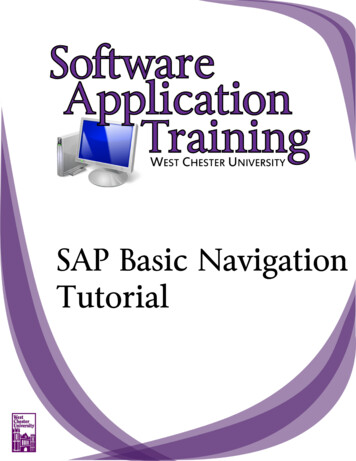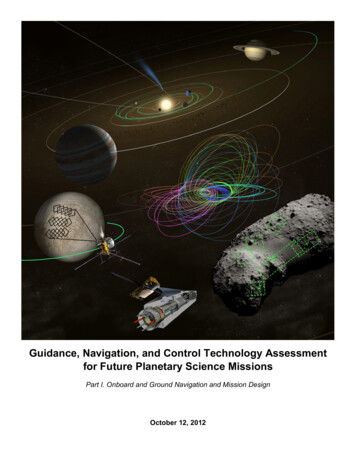
Transcription
Guidance, Navigation, and Control Technology Assessmentfor Future Planetary Science MissionsPart I. Onboard and Ground Navigation and Mission DesignOctober 12, 2012
National Aeronautics andSpace AdministrationJet Propulsion LaboratoryCalifornia Institute of TechnologyPasadena, CaliforniaGuidance, Navigation, and Control TechnologyAssessment for Future Planetary Science MissionsPart I. Onboard and Ground Navigation and Mission DesignStrategic Missions and Advanced Concepts OfficeSolar System Exploration DirectorateJet Propulsion Laboratory, California Institute of TechnologyforPlanetary Science DivisionScience Mission DirectorateNASAWork Performed under the Planetary Science Program Support TaskOctober 12, 2012JPL D-75394AuthorsJet Propulsion Laboratory, CaltechLincoln J. Wood (Lead)Shyam BhaskaranJames S. BorderDennis V. ByrnesLaureano A. CangahualaTodd A. ElyWilliam M. FolknerCharles J. NaudetWilliam M. OwenJoseph E. RiedelJon A. SimsRoby S. WilsonAdvisory CommitteeJet Propulsion Laboratory, CaltechPatricia M. BeauchampJames A. CuttsJHU Applied Physics LaboratoryYanping GuoAeroDank, Inc.John W. DankanichUniversity of Colorado at BoulderDaniel J. ScheeresNASA Goddard Space Flight CenterDavid C. Folta
Strategic Missions and Advanced Concepts OfficeJPL D-75394ForewordFuture planetary explorations envisioned by the National Research Council’s (NRC’s) Visionand Voyages for Planetary Science in the Decade 2013–2022,1 developed at the request ofNASA Science Mission Directorate (SMD) Planetary Science Division (PSD), seek to reachtargets of broad scientific interest across the solar system. This goal can be achieved by missionswith next-generation capabilities such as innovative interplanetary trajectory solutions, highlyaccurate landings, the ability to be in close proximity to targets of interest, advanced pointingprecision, multiple spacecraft in collaboration, multi-target tours, and advanced robotic surfaceexploration. Advancements in guidance, navigation, and control (GN&C) and mission design—ranging from software and algorithm development to new sensors—will be necessary to enablethese future missions.Spacecraft GN&C technologies have been evolving since the launch of the first rocket.Navigation is defined as the science behind transporting ships, aircraft, or spacecraft from placeto place; particularly, the method of determining position, course, and distance traveled.Guidance is defined as the process of controlling the flight path of a vehicle so as to reach adesired target. Control is defined as the onboard manipulation of vehicle steering controls totrack guidance commands while maintaining vehicle pointing with the required precision. Asmissions become more complex, technological advancements of GN&C systems must keep pace.Recognizing the significance of this research, the National Research Council of the NationalAcademies listed many GN&C technologies as top priorities in the recently released NASASpace Technology Roadmaps and Priorities: Restoring NASA’s Technological Edge and Pavingthe Way for a New Era in Space2 (see Appendix A).This document—Part I, Onboard and Ground Navigation and Mission Design—is the first in aseries of three technology assessment reports evaluating the capabilities and technologies neededfor future missions pursuing SMD PSD’s scientific goals. These reports cover the status oftechnologies and provide findings and recommendations to NASA PSD for future needs in GN&Cand mission design technologies. Part I covers planetary mission design in general, as well as theestimation and control of vehicle flight paths when flight path and attitude dynamics may betreated as decoupled or only loosely coupled (as is the case the majority of the time in a typicalplanetary mission). Part II, Onboard Guidance, Navigation, and Control,3 will cover attitudeestimation and control in general, as well as the estimation and control of vehicle flight paths whenflight path and attitude dynamics are strongly coupled (as is the case during certain critical phases,such as entry, descent, and landing, in some planetary missions). Part III, Surface Guidance,Navigation, and Control,4 will examine GN&C for vehicles that are not in free flight, but thatoperate on or near the surface of a natural body of the solar system. Together, these documentsprovide the PSD with a roadmap for achieving science missions in the next decade.Patricia M. BeauchampStrategic Missions and Advanced Concepts OfficeSolar System Exploration DirectorateOctober 12, 2012GN&C Technology Assessment for Future Planetary Science Missions—Part I. Onboard and Ground Navigation and Mission Designi
Strategic Missions and Advanced Concepts OfficeJPL D-75394AcknowledgmentsThis work was conducted as part of the Planetary Science Program Support task that the JetPropulsion Laboratory carries out for the National Aeronautics and Space Administration’s(NASA’s) Planetary Science Division. The research was carried out at the Jet PropulsionLaboratory, California Institute of Technology, under a contract with NASA. Gordon Johnston isthe NASA program executive responsible for this work funded under the Technology sub-task.Reference herein to any specific commercial product, process, or service by trade name,trademark, manufacturer, or otherwise, does not constitute or imply its endorsement by theUnited States Government or the Jet Propulsion Laboratory, California Institute of Technology.Special thanks to Christina Pekarek for support during preparation of this report and to RichardBarkus for development of the cover. 2012. All rights reserved.Other Reports in This SeriesPower Technology Advanced Radioisotope Power Systems Report, Report No. JPL D-20757, March 2001. Solar Cell and Array Technology for Future Space Missions, Report No. JPL D-24454,Rev. A, December 2003. Energy Storage Technology for Future Space Science Missions, Report No. JPLD-30268, Rev. A, November 2004.Planetary Protection Technology Planetary Protection and Contamination Control Technologies for Future Space ScienceMissions, Report No. JPL D-31974, June 2005.Extreme Environments Technology Extreme Environment Technologies for Future Space Science Missions, Report No. JPLD-32832, September 2007. Assessment of Planetary Protection and Contamination Control Technologies for FutureScience Mission, No. JPL D-72356, January 2012.In PreparationGuidance, Navigation and Control Technology Guidance, Navigation, and Control Technology Assessment for Future Planetary ScienceMissions: Part II. Onboard Guidance, Navigation, and Control Guidance, Navigation, and Control Technology Assessment for Future Planetary ScienceMissions: Part III. Surface Guidance, Navigation, and ControlGN&C Technology Assessment for Future Planetary Science Missions—Part I. Onboard and Ground Navigation and Mission Designii
Strategic Missions and Advanced Concepts OfficeJPL D-75394Table of ContentsExecutive Summary .11Study Overview .41.1 Introduction .41.2 Mission Design and Navigation Methods .51.3 Precision Tracking, Guidance, Navigation, and Control .51.4 Onboard Autonomous Guidance, Navigation, and Control .61.5 Summary .71.6 Sources of More Detailed Background Information.72Mission Design Technologies .72.1 Need for Further Development of Mission Design Capabilities .72.2 Multiple Encounter Tour Design .82.3 Close-Proximity Trajectory Design for Small-Body Missions.92.4 Low-Energy Trajectory Design and Optimization .102.5 Multiple-Spacecraft Trajectory Optimization.112.6 Low-Thrust Trajectory Design and Optimization .112.7 Concluding Remarks .123Navigation Technologies.133.1 Improvements in Dynamical and Measurement Modeling.133.1.1 Precise One-Way Radio Metric Tracking .133.1.2 Other Necessary Improvements .163.2 Autonomous Navigation .163.2.1 Autonomous Aerobraking .173.2.2 Outer Planet Tour .173.2.3 Primitive Body/Lunar Proximity Operations and Pinpoint Landing.183.3 Beyond the Current Deep Space Network .193.3.1 Evolutionary Improvements in DSN Radio Metric Data Accuracy.193.3.2 Derivation of Metric Tracking Data from Optical Communication Links .203.3.3 X-Ray Pulsar Navigation.223.4 Closing Remarks .234Key Findings and Recommendations .23Appendix A: Pertinent GN&C Challenges and Technologies in the NASA Space Technology Roadmap .26Appendix B: Supporting Material from Astrodynamics White Paper .30Acronyms .33References.34List of TablesTable 2.7-1. Key advances in mission design capabilities. .12Table 2.7-2. Missions types benefiting from proposed advanced mission design capabilities. .13GN&C Technology Assessment for Future Planetary Science Missions—Part I. Onboard and Ground Navigation and Mission Designiii
Strategic Missions and Advanced Concepts OfficeJPL D-75394List of FiguresFigure 1.2-1. Interplanetary trajectory design can leverage electric propulsion to enable new missions and reduceproject risk.5Figure 1.4-1. Example of AutoGNC system capable of touch-and-go operations. .6Figure 2.2-1. Exploration of multiple encounter tour designs. .9Figure 2.3-1. Close-proximity trajectory design for small-body missions. .9Figure 2.4-1. Innovative trajectory design enables efficient low-energy transfers, captures, and orbits. .10Figure 2.5-1. Trajectory design for the GRAIL mission, with multiple spacecraft elements. .11Figure 3.1-1. Laboratory brassboard version of DSAC in a low-mass and low-volume package; accurate to 1 ns in10 days. .14Figure 3.1-2. DSAC’s Earth orbiting mission architecture. .16Figure 3.2-1. Autonomous onboard navigation for a Europa orbiter. .18GN&C Technology Assessment for Future Planetary Science Missions—Part I. Onboard and Ground Navigation and Mission Designiv
Strategic Missions and Advanced Concepts OfficeJPL D-75394Executive SummaryThe importance of research and development in the fields of celestial mechanics, trajectoryoptimization, and mission design is clearly stated in the Instrumentation and Infrastructure andRecommended Technology Investments sections of Vision and Voyages for Planetary Science inthe Decade 2013–2022.1 Deep space navigation enables missions to precisely target distant solarsystem bodies, as well as particular sites on these bodies. This navigation not only takes place inreal time for control and operation of the spacecraft, but also in many cases includes later, higherfidelity reconstruction of the trajectory for scientific and/or operational purposes. Existingtechnologies have been used in varying degrees since the early 1960s to navigate spacecraft withever-increasing precision and accuracy, and NASA’s expertise in deep space mission design andnavigation has enabled many successful planetary missions. Future missions need to build onthese successes in order to meet tightening performance requirements and growing demands forthe autonomous response of spacecraft to new environments.Progress in these technologies will allow missions—that were barely conceivable a few yearsago—to be accomplished efficiently and effectively resulting in scientific insights andunderstanding far beyond what is currently in hand. For example, investment in new missiondesign techniques would Enable new planetary science missions by developing design techniques for new missionclasses and reducing required resources on others Allow increased science return by increasing science payload mass capability (reducedpropellant or higher delivered mass) and expanding the range of science opportunities(more targets accessible, more time at target, better geometry, etc.) Reduce design times by an order of magnitude, allowing more exploration of the designspace and trade studies to increase science quality and quantityThis document—Part I, Onboard and Ground Navigation and Mission Design—is the first ina series of three technology assessment reports that evaluate the current status of guidance,navigation, and control (GN&C) and mission design capabilities, and provide a roadmap fortechnologies needed in the future. This report includes a number of findings andrecommendations, which are summarized below.Finding 1The exceptional ingenuity and creativity of scientists and engineers ensures that new missionconcepts appear continually. In order to meet these creative challenges, mission designers mustbe able to rapidly design efficient and innovative trajectories; otherwise, opportunities for newmissions will be lost. Much of the current mission design capability is based on techniquesdeveloped decades ago and is frequently unable to support these new concepts. Somedevelopment of new mission design capabilities occurs naturally as a result of flight projectactivities and pre-project studies, but more research is needed.Recommendation: Significantly more resources should be made available to mission designtechnology development, a long-neglected area of research. A stable, long-term commitment tofund research and innovation should be made, separate from the funding of specific planetarymissions. Mission design needs should be explicitly included in future NASA technology roadmaps.GN&C Technology Assessment for Future Planetary Science Missions—Part I. Onboard and Ground Navigation and Mission Design1
Strategic Missions and Advanced Concepts OfficeJPL D-75394Finding 2Deep space navigation functions, traditionally performed on the ground, can be mission enablingor enhancing in certain situations when moved onboard a spacecraft. Round-trip light-time delaycan be eliminated, as can the need for a constantly available two-way spacecraft-groundcommunication link at critical times. The onboard navigation software can be a compact,simplified version of the ground software. Both continued onboard GN&C system-level workand specific, focused application developments are important. Standards for interfaces are alsoneeded in order to allow modular autonomous navigation software applications to work on avariety of spacecraft built by various companies and laboratories.Recommendation: Both continued onboard GN&C system-level work and specific, focusedapplication developments should be pursued. Moreover, the development of standards forinterfaces would facilitate the use of modular autonomous navigation software applications on avariety of spacecraft built by various companies and laboratories.Finding 3The Deep Space Network (DSN) has been a cornerstone of deep space navigation for many yearsand will remain so for years to come. Some improvements in capabilities will take place in anevolutionary fashion, without affecting the basic use of the DSN for navigational purposes. Theseimprovements will be driven by the use of higher transmission frequencies, driven largely bytelecommunication considerations, and by improvements in electronics and computing capabilities,along with reductions in transmission times between the sites at which data are collected and thesites at which they are processed. It is important for the tracking capabilities of the DSN toimprove with time, as technological advances allow, rather than to remain static or regress.Recommendation: The PSD should advocate that NASA’s Space Communications andNavigation (SCaN) program provide for future funding of the DSN to enable continuedimprovement of radio metric tracking data accuracy.Finding 4The Deep Space Atomic Clock (DSAC) can use the DSN in new and more efficient ways; forexample, relying much more on one-way communication links.Recommendation: Innovations such as DSAC, which offer improvements in tracking dataaccuracy and efficiency, need to be brought to flight readiness and put into use in a variety ofapplications. The Office of the Chief Technologist (OCT)
precision, multiple spacecraft in collaboration, multi-target tours, and advanced robotic surface exploration. Advancements in guidance, navigation, and control (GN&C) and mission design— ranging from software and al

